The Origins of British Dance Music, Rave & Club Culture: Part 2 Balearic Beat & Acid House
The Origins of British Dance Music, Rave & Club Culture: Part 1
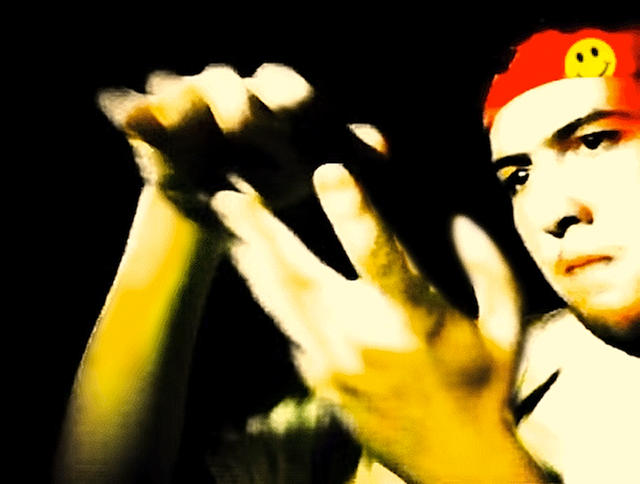
Acid House clubber at RiP, Clink Street Studios, summer 1988
Before House Had A Home
Mark Moore: "I remember Colin [Faver] playing house music when it didn’t have a name."
http://www.telegraph.co.uk/news/obituaries/11851373/Colin-Faver-DJ-obituary.html
As far back as 1985 Camden Palace resident DJs Colin Faver and Evil Eddie Richards were both regularly playing Chicago house records to London audiences, slowly introducing them into their sets alongside the Italo-Disco, Synth-Pop, Go-Go, Cha-Cha, New Wave, Electro and Hi-NRG they were also spinning. A year later, though, house was still not really taking root and was still seen by most punters and DJs as another type of music to be mixed with the already varied mix.
Mr. C: "In late 1985 house music had started to trickle through in the gay clubs, at the Camden Palace and also mixed in with Disco, Funk and Rare Groove at various warehouse events.."
http://www.publicpressure.org/mr-c-remembers-pioneer-colin-faver/
Eddie Richards: "Both Colin [Faver] & myself were including Chicago house music in our sets at the Palace as early as 1985, it was a natural progression from the drum machine based electronic dance & Italo-disco we had been playing all along."
http://www.sixamatthegarage.com/words/interviews/q-a-eddie-richards/
Eddie Richards: "We used to get special versions of things that no one else had, test pressings and dub mixes that no one had, so you’d play two copies of the same 12-inch for like 15 minutes, and that’s what I used to do. They’d hear completely different versions at the Camden Palace. I was probably one of the first DJs to start playing house. First time I remember hearing about warehouse parties was in 1986 with things like Dirtbox and Jay Strongman"
https://web.archive.org/web/20160323020731/http://www.djhistory.com/interviews/eddie-richards
Below is a small selection of the types of records played at the Camden Palace during the early/mid 80s
Mr. Fingers // Mystery Of Love (Dub Version 1985)
Deekay Jones - New York New York
J.M. Silk - Music Is The Key (House Key)
Alexander Robotnick - Problemes D'Amour
Gino Soccio - Remember (Atlantic Records)
Colin Faver Interview (from unreleased documentary 'They Call It Acid')
Between late '86 to early '87 London DJ Mark Moore, of S-Express fame, was also mixing Chicago house and Detroit techno records to the mostly gay audiences at two of the nights that he played at, Pyramid (at Heaven) and Mud Club (at Busby's). Also, a lot of house was getting played at Jungle, another mixed gay night (also at Busby's), by DJs Vicki Edwards, Fat Tony and Colin Faver.
Mr. C: "I followed Colin around his London shows, went every Wednesday to Pyramid at Heaven, a gay night with Colin playing with Mark Moore (S-Express) and Ian B (Eon, RIP). They played House, Acid and Techno all night long."
http://www.publicpressure.org/mr-c-remembers-pioneer-colin-faver/
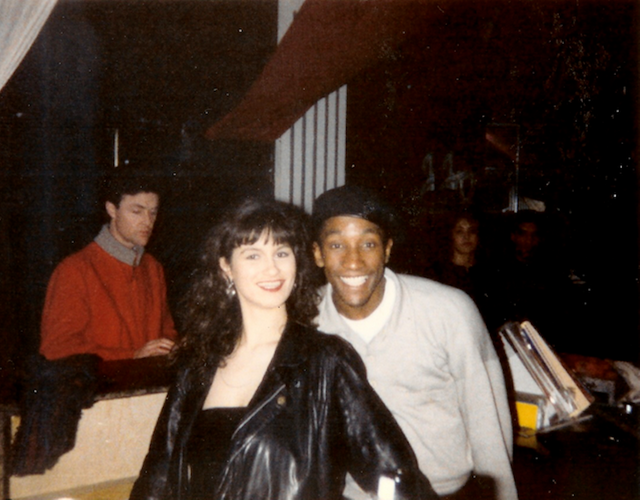
DJ Vicki Edwards and Tony Felix at Jungle (Picture by Steve Swindells)
Raze - Jack The Groove (ORIGINAL 12" VERSION)
2 Puerto Ricans A Blackman And A Dominican - Do It Properly (Fierce Club Mix)
Mark Moore: "By 1986 and '87 I was merely a stoner. I played strange records from Detroit and Chicago at the Pyramid (in Heaven) and the Mud Club in London while Colin Favor - the first person I heard play a Chicago record - spun at both Pyramid and The Jungle."
https://www.theguardian.com/music/musicblog/2008/apr/20/wecallitaciiiiiieeeedcontd
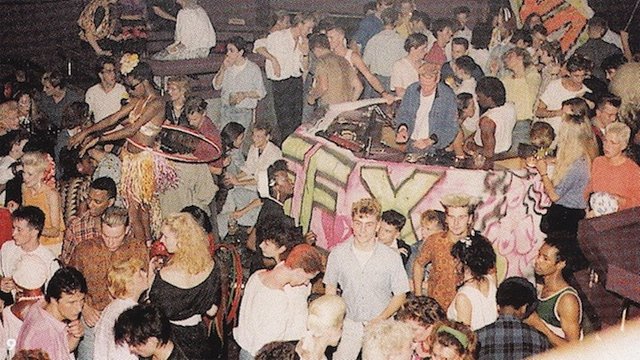
Mark Moore DJing at Mud Club
Although house music was already widely appreciated in the gay clubs, overall, most London clubbers held pretty snobbish attitudes to music. It was pretty common to see puritan 'Soul Mafia' punters standing around pining after the 'rarest of rare' soul or retro-funk 7 inches - the least amount of people that had heard of the record the better. Slower paced rare groove was very-much the music of choice at the time.
Mark Moore: "You’d play amazing records like Strings of Life at Heaven and the gay crowd would get it immediately,” he says, “but at a warehouse party people didn’t know how to dance to it."
https://www.theguardian.com/music/2016/may/19/s-express-ecstasy-acid-house-why-drag-new-punk
In the North of England and the Midlands house music was embraced much more enthusiastically. DJs like Mike Pickering in Manchester, Graham Park in Nottingham and Winston and Parrot in Sheffield were mixing sets that would almost completely comprise of house music. Occasionally they would even play some of the harder, more tripped-out Detroit techno records. Up North it was quite common to dance to DJs playing Chicago and Detroit records all night... with a little hip hop or current dance pop music thrown in for measure. The ratios were almost the polar opposite to what was heard in most straight London clubs. The reason for the North's adoption of this new raw 4/4 sound may be to do with the Norther Soul scene which had dominated the clubs of Manchester and other nearby northern cities and towns over the previous decades, where club-goers would dance all night to fast-paced 4-to-the-floor dance music while under the influence of stimulates like amphetamines - the parallels to the rave scene that was to come are uncanny.
Delirium Plays House!
During their first incarnation at The Astoria in '86 (Delirium moved to Heaven the following year), Delirium DJs Noel and Maurice Watson first introduced house music to a mostly Hip Hop crowd who were not too pleased with the clubs change in musical direction, so much so that a cage had to be built around the DJ booth to stop the missiles that were regularly being thrown at the DJs from the unhappy mostly black Hip Hop crowd. This kind of reaction was pretty prevalent in many of the straight clubs in the capital. House music was just too visceral and raw for most of the established weed-smoking clubbers to bear. Initially they just simply hated it.
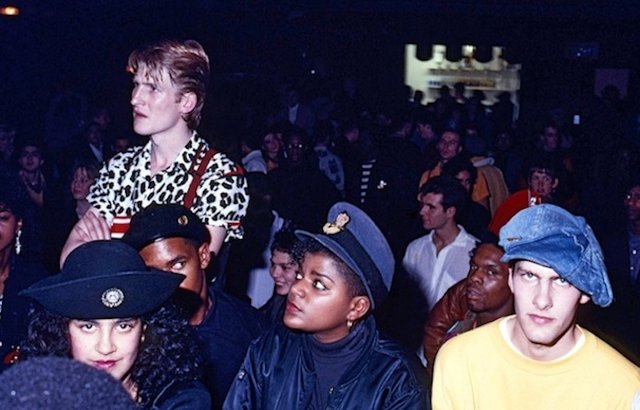
Delirium at The Astoria, 1987
Noel Watson: "Well, Maurice [Watson] had met a girl in New York through the Comme Des Garcon's shows, so he was going back and forward to New York and buying records, and he’d been the first to turn me onto House. He’d already started only playing classic Disco records at the Delirium! nights at the Astoria. He’d drop the odd Hip Hop track, usually because he’d brought them back over from New York and nobody had heard them in the UK before. Just Ice`s “Cold Gettin’ Dumb” is a perfect example, but after BATTLEBRIDGE Maurice suddenly wanted to only play Disco, things like MFSB and tracks like Sylvester’s “Over And Over” and ‘Bad Luck” by Harold Melvin and The Blue Notes. Big tunes that he was hearing Larry Levan play at the Paradise Garage, where he would go constantly whilst in New York. These records at that time, in London, were very unfashionable. Very few DJs at that time had the balls to drop music like this, especially as we had 2000 kids in there. Remember all these kids where coming to the Astoria on a Saturday night to hear Public Enemy playing live, or Schooly D, and suddenly my brother`s hitting them with out and out Disco which, for some of them, was too much to take, they thought of it as ‘Gay” music and they did get vexed. I’d usually be the one to come on and placate them with a cut-up of Hip Hop breaks, but Maurice was like “fuck them”… and then Boom!..he heard House…that was it…He loved the Gay overtones of the music, and Hip Hop for him was dying. House was a new genre of dance music that was so fresh and innovative we had to play it. House was like space age music, with weird drugged out vocals. “Bring Down The Walls” by Robert Owens. Uplifting soulful vocals too, mixed with the harder House beats. Because in it’s earliest forms a lot of the house producers made records inspired by the classic Disco that they danced to at clubs like the Garage, and the loops that DJs like Ron Hardy and Frankie Knuckles were dropping in Chicago live on reels."
http://testpressing.org/feature/noel-watson-interview-part-2-peak-delirium/
By September of '87 cracks starting to appear and it was really only a matter of time before the stale old rare groove guard fell apart, paving the way for the new unstoppable energy that was brewing on the fringes of clubland.
Terry Farley: "At first you just had little pockets of people who knew about house. The very first people to get into it were those from London, Manchester and Sheffield who had been out working in Ibiza in the summers of 1986 and '87 and been exposed to it there."
https://www.theguardian.com/music/2008/apr/20/electronicmusic.culture
Noel Watson: "You know, it took me a while to get with this. To me this new influx of sweaty little South London and suburban kids dressed in smiley baggy T-shirts and dungarees wasn’t particularity my cup of tea!…I was a Soho West London boy. I loved my Comme Des Garcon, Yohji Yamamoto, and I was choosy about who we’d let into our nights. Some of these people were former thugs and casuals, and I didn’t like them, I have to be honest. But then it progressed and took on a life of its own."
http://testpressing.org/feature/noel-watson-interview-part-2-peak-delirium/
Mark Moore: "In my first interview for the NME I said that London's drug of choice was weed and if the drug changed the choice of music would change too. To the old school, House music was equated with fag music and until they popped their first pill they just plain didn't get it. But boy-oh-boy, when that first pill exploded in their unsuspecting minds did they get it with a born-again vengeance. 'Get right on one matey,' indeed."
https://www.theguardian.com/music/musicblog/2008/apr/20/wecallitaciiiiiieeeedcontd
Robert Owens - Bring Down The Walls
Noel Watson: "I wouldn’t say it was all down to ecstasy, though ecstasy was the catalyst and without that drug there’s no way the whole Acid House scene would have happened. Drugs have always been a major part of any musical revolution. In the `50s with Jazz it was pot and heroin, the `60s acid, the `70s cocaine, and in the `80s ecstasy. It was a natural progression. The drug complemented the music. People were completely changing their personalities and becoming a lot more tolerant and accepting of different types of people."
http://testpressing.org/feature/noel-watson-interview-part-2-peak-delirium/
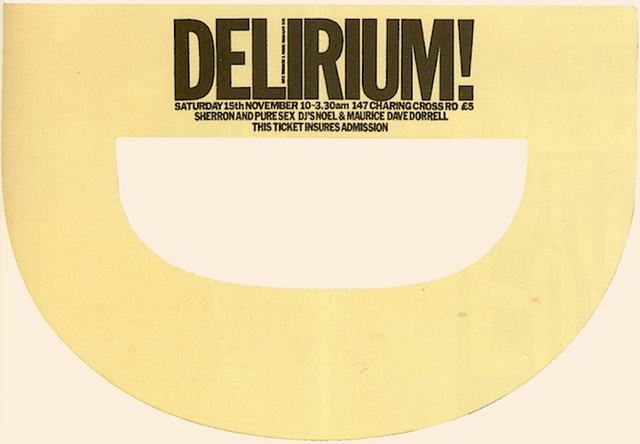
Deliriums flyer, 15th November 1987
At this point things really started to noticeably change at Delirium. All the people returning home from the summer season in Ibiza, re-energised by their adventures on the sun-drenched island, were looking for a place to indulge their new found fondness for dancing to house music and popping Es or acid tabs, sometimes both at the same time (candyFlipping).
Robin King: "At Delirium, we slowly created a hardcore following of about 100 people, including the likes of Paul Oakenfold and Danny Rampling, known as the Ibiza crowd. With the first cries of “Aciiiiiied”, people started to dance wildly pumping arms in the air, rather mechanically, even after the music had stopped. Somewhat snobbishly, it wasn’t exactly how I imagined dance culture to be, since I always aspired to higher intellect than glaring into someone’s sweaty face and shouting : “On one, matey!!!"
http://www.culturebomb.com/wp-content/uploads/2013/10/Delirium-Text_En_NEW.pdf
After trying many of the other club nights in London eventually the Ibiza crowd found that the best place to dance to house music most of the night, or until 3am (due to licensing at the time), was Delirium at its new home at Heaven, under the arches in Villiers Street, Charing Cross.
Below is a mix by Noel Watson of the sort of sets that he was playing at Delirium during this time.
http://testpressing.org/audio2/371_Noel_Watson_Peak_Delirium.mp3
The growing group of brightly coloured 'sudo-hippies' with beads around their necks, dressed in baggy jeans or dungarees, Converse All-Stars and multicoloured sweatshirts, danced the night away with the same frenzied uninhibited passion that they had done the previous months in Ibiza, while many of the regulars looked on disapprovingly.
Adam Heath: "There'd be about thirty of us in the club, standing in one corner, all dancing, and the rest of the club would be looking at us like, "Where the fuck did this lot land from?" We wanted to dance all night and there was nowhere to do it. When it shut we'd be stamping and jumping and screaming."
Altered State: The Story of Ecstasy Culture and Acid House By Matthew Collin
Noel Watson: "They were all in ponchos, dancing on the speakers, popping Es. It was like: "What the fuck is going on here?" I didn't want to have them in the club!' 'I told some of the door Staff:'"Don't let them in, they're thugs from south London, I know they're thugs, they're casuals, we don't want casuals in the club." Then I started realising that they were cool."
Altered State: The Story of Ecstasy Culture and Acid House By Matthew Collin
Danny Rampling: "The people who had been in Ibiza had brought back a bit more of a hippy-ish look - and the clubs were so hot because a lot of them were in smoky basements full of strobe lights. So, naturally, people changed their dress sense and started weaning baggier clothes."
https://www.theguardian.com/music/2008/apr/20/electronicmusic.culture
Little did many of the rare groove and hip hop regulars realise but within a matter of months they too would be joining forces with these new, strange, wildly dancing, drugged up interlopers. The cat was well and truly out of the bag. There was definitely something going on here, something that couldn't be ignored.
Danny Rampling: "So many people dissed it in the early stages, at the tail end of 1987, and then, all of a sudden, people's enthusiasm for the whole experience just exploded in a matter of weeks. I can still see the faces of people in some of the clubs, the look of bewilderment was just astonishing. It was like, 'God, you don't know what we're experiencing here, you don't know what you're missing out on.' Subsequently, a lot of those people joined the party, around the late summer of 1988, particularly a lot of the old rare groove and funky crowd. They weren't going to miss out on the greatest thing that had come along in years."
https://www.theguardian.com/music/2008/apr/20/electronicmusic.culture
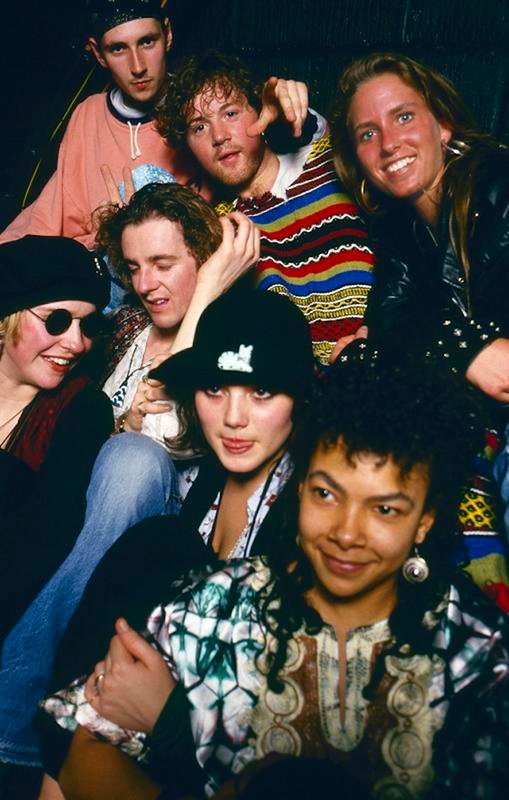
Some of the Balearic Crowd (Picture by Dave Swindells)
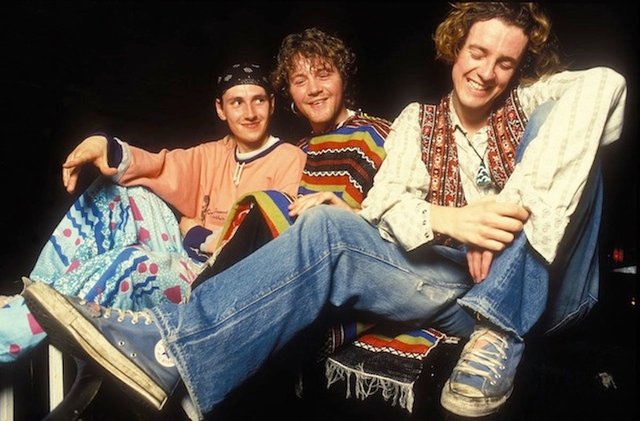
Some of the Balearic Crowd (Picture by Dave Swindells)
The Ibiza Reunion Party @ Ziggy's Wine Bar, Streatham
Although the music that Noel Watson was playing at Delirium was a tremendous leap in the right direction, the atmosphere at the club itself just wasn't right. It belonged to the older generation of trendy West-End glitterati and just didn't feel like home, besides, Delirium would closed it's doors for good in December of '87 due to financial problems.
The Balearic crowd now needed a proper Balearic style club of their own where they could continue doing exactly what they were doing in Amnesia, without scorn and ridicule from misunderstanding onlookers.
In September of '87 Paul Oakenfold asked the owners of the wine bar (Ziggy's in Streatham) where he had already established a funk, soul and hip hop night called The Project Club if he, Trevor Fung and Ian St Paul could continue using the place after it closed at 2 am for a small Ibiza reunion night. It was agreed that he could use the place until 6 am for a private invite only party. Soon all the Ibiza clubbers, whom they let in through the back doors, arrived, along with hundreds of ecstasy pills, which had been imported from Amsterdam via Manchester. At this point Ecstasy was still pretty rare and could be smuggled into the country undetected as the police and customs didn't really know what it looked like.
The sound system for The Project Club was supplied by Carl Cox, a South London DJ who was, at time, still trying to break into the scene. Cox mused at this music that they were calling 'Balearic' - likening it to the same kind of mix that he would be plying at weddings as a mobile DJ for hire.
Paul Oakenfold: "We didn't have a licence, the Ibiza reunion was completely illegal. At half past two we opened the side door, and all these people poured in. Everyone had stayed in touch from Ibiza, they knew that we were having the after-party, so they all came down. People came from Sheffield, from Manchester, a couple of lads from Birmingham; all the workers we'd got to know in Ibiza. A whole load turned up. I was Djing for Boys Own parties at the Wag, and I played at the Raid a lot. I Knew Gary Haisman, Terry Farley and Paul Dennis, so I invited them down to the Project. They all turned up in floppy cloth hats, that rare groove look; they'd come from the rare groove scene. When they saw it, once they'd seen what was going on, it all changed for them, too."
- Paul Oakenfold: The Authorised Biography by Richard Norris
Still riding high on the wave of excitement and energy conjured up by their experiences at Amnesia the three of them poured all they had into preparing for the after hours Ibiza reunion and in the process disregarded any idea of compliance with licensing laws, a mistake that would eventually be the clubs downfall.
The party was a huge success with revellers still going until 7am the next morning, fuelled by the 'little fellas' from Amsterdam and the big box of Balearic vinyl gleaned from Alfredo's live mix tapes from Amnesia.
Trevor Fung: "It wasn't just me and Ian. By the time we came back to South London from Ibiza everyone knew about it. The Project Club was rammed solid. It was brilliant. Everyone knew it was going to be busy - it was packed during the normal night, earlier on; everyone had heard something was going on, and were all trying to get in. We were changing the music then, switching it over. everyone was totally up for it."
- Paul Oakenfold: The Authorised Biography by Richard Norris
Thrashing Doves- Je$u$ On The Payroll
The Residents -- Kaw-Liga (Prairie Mix)
Code 61 - Drop The Deal
Along with all the other party-goers, who came from all over England, there was a small group of harden music and football fans from East London who would become well known for the fanzine that they produced called Boy's Own. Terry Farley, Andy Weatherall, Pete Heller and Cymon Eckel would later go on to be central players in the UK house music scene.
The Project ran for around 6 weeks before eventually being stopped by the police after a parking violation outside sparked a call from the local supermarket management. After this, once again, the Balearic crew found themselves with nowhere else to party other than the 'trendy' or gay West End clubs. Something had to change on a more concrete, permanent basis.
The Future @ The Sanctuary (at the back of Heaven)
Mark Moore: "Next thing I know Paul Oakenfold (who would come to my nights armed with records from the promotion company he was working for) is telling me to come to his club - The Future."
https://www.theguardian.com/music/musicblog/2008/apr/20/wecallitaciiiiiieeeedcontd
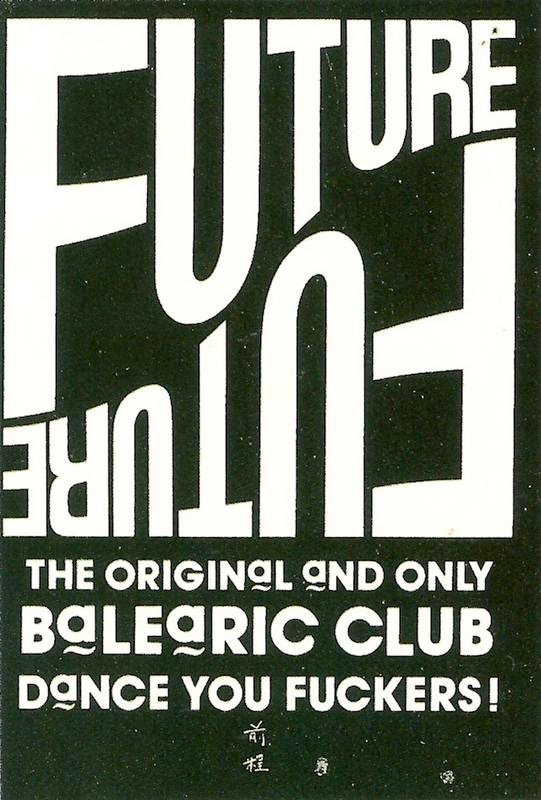
Flyer for Future
In November, after The Project Club’s after-hours Ibiza reunion was shut down by the police, Paul Oakenfold and Ian St Paul booked the Sanctuary, a small arched clandestine room with black walls at the back of Heaven, for a new Thursday night party which they named Future.
Each Thursday night, the Ibiza crowd would cue outside the front doors, pay their £5 entry fee and steam through Heaven towards the delights of The Future at the back of the club, where Oakenfold, Nancy Noise and Lisa Loud played many of Alfredo's summer 'hits' from Amnesia.
'The Original and Only Balearic Club - DANCE YOU FUCKERS!' declared the flyers! Balearic Beat was now truly starting to grow as a genre and culture and the 'Amnesiacs' - as they were starting to be known as by the music and style press - had truly discovered a genuine new way of life. The Future at the Sanctuary was a happy welcoming personal space filled with close friends, freely expressing themselves, whooping with joy on the dancefloor while dancing like maniacs to the music that they loved. A cultural home.
Paul Oakenfold: "By then we saw it as the future of clubs in general."
https://web.archive.org/web/20150507163623/http://www.djhistory.com/features/the-amnesiacs-1988
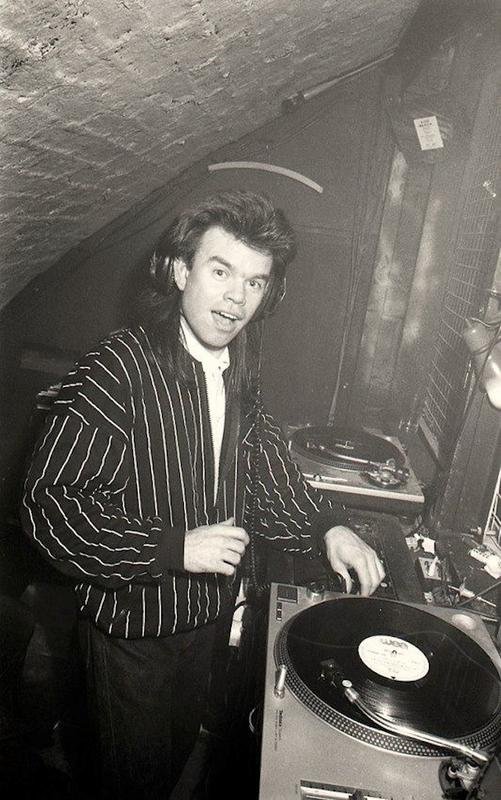
Paul Oakenfold on the decks at Future, March 1988 (Picture by Dave Swindells)
"Paul Oakenfold's Thursday nighter, The Future, loosely specialises in the so-called Balearic Beat precisely because so many of the regulars used to party to the pop-rock and house disco rhythms of Ibiza's nightlife that he recreates at the club. It's one of the vary-best new clubs to burst onto clubland so far this year, providing the appropriate aural atmosphere for the euphoric and whooping crowd to take the idea of dancing to its outer limits, way beyond the confines of the dancefloor or the two-step shuffle. It has the kind of wild, inhibited style that you'd normally only associate with mixed-gay trendy nights - it might intimidate some people but the punters are unpretentious and friendly."
- Time Out, March 1988 https://testpressing.wordpress.com/2009/09/13/time-out-paul-oakenfold-future-chart/
It's Immaterial - 'Driving Away From Home' (Full 12" Version)
Jack Frost and the Circle Jerks - Shout
The Woodentops - Why Why Why
Curtis McClaine and On The House - Let's Get Busy
Mark Moore: "The Future was very white, suburban and under the influence of Ecstasy. It was the first time since Taboo a few years back that I had seen the likes of such Bacchanalian Ecstasy taking. This delightful riff-raff, who I gather had emerged from the Eighties soul scene, were devouring it in huge amounts after discovering it in Ibiza along with discovering DJ Alfredo who was coming on all Balearic over there. They thought themselves very daring playing a Cure or Woodentops record. Outrageous!"
https://www.theguardian.com/music/musicblog/2008/apr/20/wecallitaciiiiiieeeedcontd
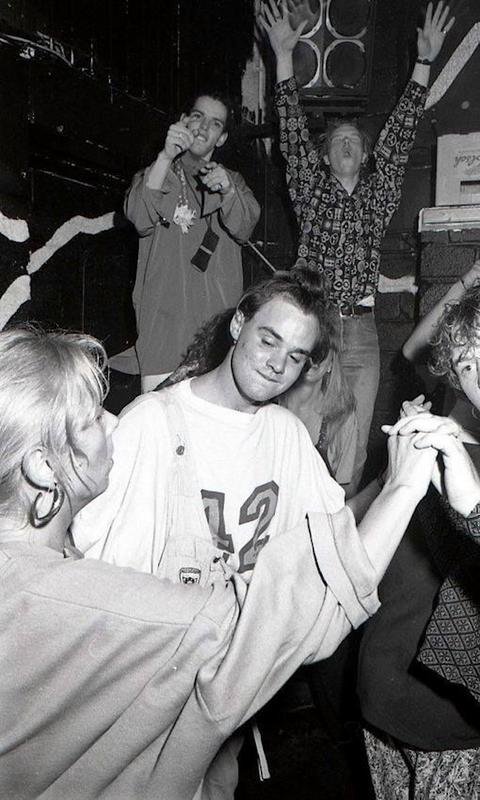
Friends dancing at Future, March 1988 (Picture by Dave Swindells)
Paul Oakenfold: "Before Ibiza I was playing LL Cool J and Run DMC but when we came back I was playing acid house and Cyndi Lauper. We had baggy trousers and were dancing like maniacs and everyone was like, 'What the fuck are you lot doing?' I started Spectrum on a Monday, which was all acid, and Future on a Friday [...that was Thursday, Paul] night, which was indie mixed with dance. That's how I ended up remixing Happy Mondays, the Cure, the Stone Roses, and touring with U2."
https://www.theguardian.com/music/2007/aug/12/electronicmusic
Wayne Anthony: "I had taken ecstasy in Tenerife the summer before, but it hadn't really done anything for me. Then someone took me to Future one night. I didn't really know what to expect. I turned up in a three grand suit! Everyone looked like they had just come back from Ibiza. I had half an E and was totally euphoric. There was a huge positive energy being given out by everyone and I just knew it was something special. I knew it could change my life."
https://www.theguardian.com/music/2008/apr/20/electronicmusic.culture
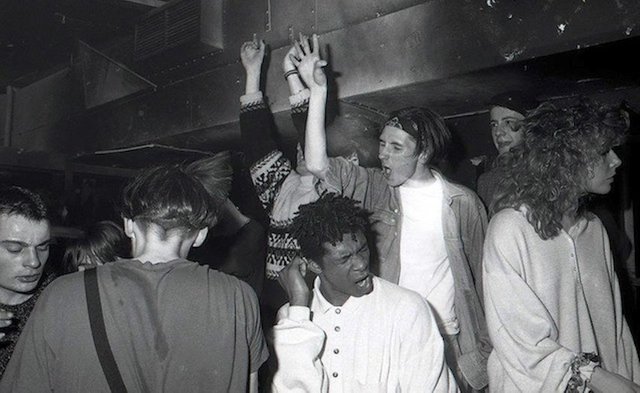
Friends dancing at Future, March 1988 (Picture by Dave Swindells)
Terry Farley: "Future was Ibiza dance brought to one of London's darkest clubs, with a soundtrack consisting of some of Amnesia DJ Alfredo's rockiest moments. These particular record driving a whole club crazy would have been unthinkable only six months earlier. The dancers were Ibiza workers, DJs and grafters from the just finished '87 season - they were later called the 'Amnesiacs'. Their dance moves shaped acid house culture the following year. The DJ's at the night initially were Oakey and the amazing Nancy Noise."
https://thump.vice.com/en_uk/article/ae83eb/heller-and-farleys-comprehensive-history-of-clubbing
Below - Leo Mas (DJ from Amnesia, Ibiza) was given this tape by Paul Oakenfold’s in 1988 of The Future from June that year. Nancy and Paul mixing up the Balearic Beats.
http://testpressing.org/audio2/353_The_Future_London_June_1988.mp3
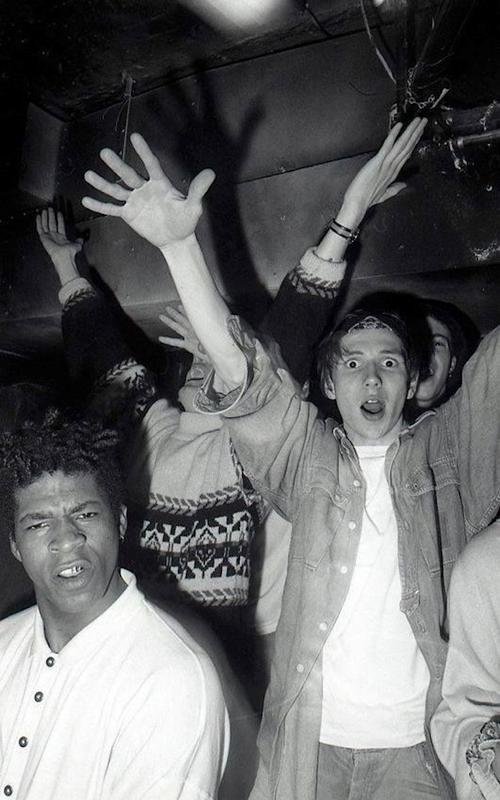
Dancing on ecstasy at Future, March 1988 (Picture by Dave Swindells)
Shoom Into '88
appyammer - on the origins of the word 'shoom: "We met this really tall guy with long fuzzy hair from Wolverhampton called Keith. He was one of the Stars security team. He was also a bit of a petty thief who wore dungarees in the day time (which I thought looked a bit Whamish!). His unusual slang term for thieving was “shooming”. I “shoomed” some clobber from Ibiza town today, I “shoomed” some credit cards from some dopey twat on the beach today... that kind of thing. Trev kept using the same term as well and would snatch things out of your hand saying “shoooom”. I remember thinking “what the ****s this shoom bollocks all about?” It became a catchphrase and took on different connotations as the weeks went by. Personally I would have spelt it shum, but a certain other fella I knew (a Rare Groove and Soul DJ from Punters Wine Bar Kingston) who turned up a week later had another way of spelling it. By the time he’d arrived Shoom also had an entirely different meaning. I don’t know how true the “it’s the feeling you get as your E kicks in” translation from Trev to Danny is, but to this day it has always meant something entirely different to me."
http://ldnbcnstory.blogspot.co.uk/2011/11/great-posts-5.html
Terry Farley & Dave Jarvis on going to Shoom
On the 5th of December 1987 in a small gym just south of the themes in Southwark, Danny and Jenni Rampling opened Klub Sch-oom. The area was popular with the warehouse party organisers as it was out of the way and loud music didn't attract the attention of the authorities too much. Danny had previously played at the venue at an engagement party in the early 80s and he had always remembered the place as a great venue to one day have a club night in as it was out of the way and you could keep it going until the next morning without any bother. As soon as he got back from Ibiza he rushed over there and asked the owners if he could hire out the place for his new club and they agreed straight away.
The fitness centre was a small basement room which could hold about 250 people with a small bar which they would use to sell soft drinks, mostly just Lucozade - as it 'was what they sold at the fitness centre'. Lucozade later became popular on the scene in part due to it being sold at Shoom. A few years later Adamski used the bottle on the cover of his N-R-G single - only later Beechams (producers of Lucozade) requested that Adamski pay £2,500 to charity for the unauthorised usage. His record label eventually paid the money to the Nordoff Robbins music therapy charity.
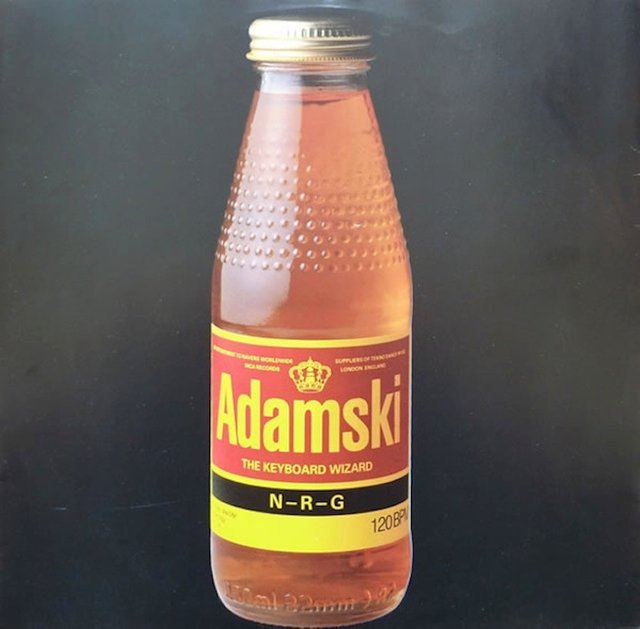
Cover of Adamski's 1989 N-R-G single
Like before at The Project Carl Cox would supply the sound system, but this time he would also DJ alongside Danny for the first few weeks of Sch-oom. The flyer read 'Sensation seekers, let the music take you to the top', subtly alluding to the effects of taking ecstasy whilst listening to chicago house music and detroit techno. Ultimately the sentiment spelled out on the flyer was an understatement. The reality would be much more sensational than anyone could have imagined.
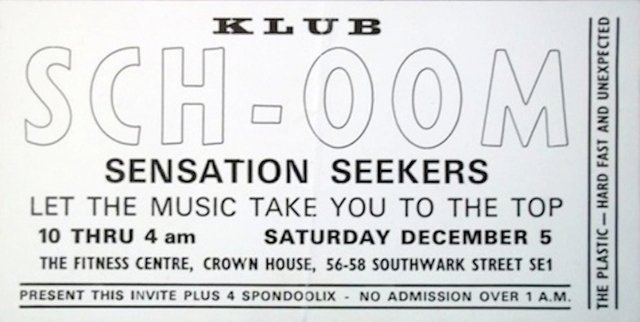
Flyer for the first Shoom night
Noel Watson: "I remember Jenni Rampling coming asking us to play at Shoom one night when I was DJing at Heaven. They’d just started their club, they were on it though. It was all exploding at the time. Ecstasy had really begun to hit the scene big time and the kids were looking to go out and hear House music as much as possible, especially Paul and Danny’s crowd. They had created a new underground movement combining their love of Ibiza’s Balearic scene and the newly discovered American House sound. It really was a great time in clubland’s history."
http://testpressing.org/feature/noel-watson-interview-part-2-peak-delirium/
Carl Cox: "I supplied the sound system for the first two Shoom club nights. Danny Rampling asked me to come down because he knew I was already into the music. It was in a fitness centre on Southwark Street in south London, but what happened in there was like nothing that had gone before. This whole rare groove movement had lasted for years in London but it couldn't really go any further, whereas house music pointed the way forward."
https://www.theguardian.com/music/2008/apr/20/electronicmusic.culture
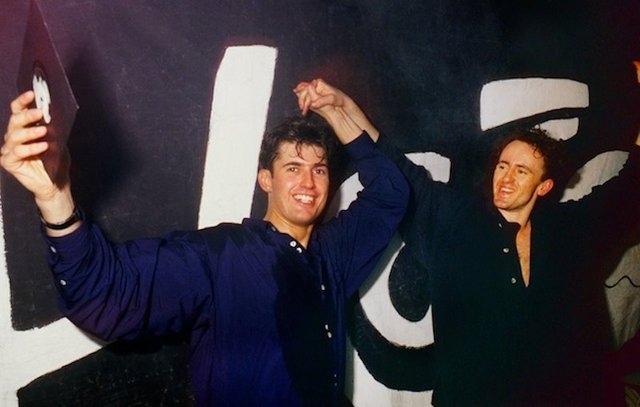
Johnny Walker and Danny Rampling at Shoom (Picture by Dave Swindells)
On the first night about a hundred and fifty people turned up. The night wasn't quite the success that they'd hoped for as the music mix wasn't quite right. They had mixed the acid sounds of Chicago house and Detroit techno with rare groove and funk but each tribe didn't really feel the others vibe and it all ended a little stand-offish.
Carl Cox: "There was a transition going on. Everyone was like "What's this?" Some people hated it; with others it was like "sod this" - the wigs and flares came off - "aciieed!" It was a great time, because we all ventured into the unknown. You had to let go of the past, and enter the future.""
- Paul Oakenfold: The Authorised Biography by Richard Norris
Danny Rampling: "The first night was quite nerve-racking. Carl Cox played with me, and another guy that played funk, so it was a real mishmash really. There was funk crowd and a house crowd and it just didn't work. It was shaky but it was fun, hence the enthusiasm to do it again."
Altered State: The Story of Ecstasy Culture and Acid House By Matthew Collin
After a few weeks the Ramplings parted company with Carl Cox and bought in Norman Jay's brother's sound system along with veteran London house DJ Colin Faver. Now the fitness centre was kitted out with strobes, a dry ice machine and the walls were covered with colourfully painted drapes with images of smiley faces on them. The stylist from I-D magazine had made a jacket which he'd covered with loads of little smilie faces and worn to all the London clubs at the time. On seeing this Danny knew it was the right 'logo' to use for his club.
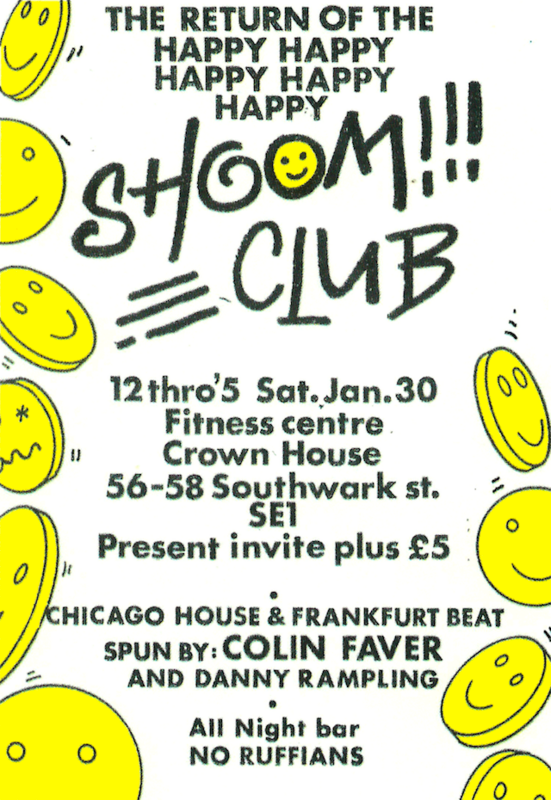
Flyer for Shoom night, Saturday 30th January 1988
At the start of 1988 the club, with its name simplified to Shoom, was going from strength to strength. The place was absolutely rocking. If you walked towards the fitness centre from Southwark Bridge you would see the small fogged up basement windows absolutely dripping with sweat. From here, if you were lucky enough to be let in by Jenni Rampling, you would then walk down the steps to be greeted by various smiling faces all introducing themselves and shaking your hand. On the left was a bar selling soft drinks, no alcohol was sold at the club and most clubbers didn't want it anyway as it was said to ruin the effects of ecstasy. After a bottle of Lucozade or a can of coke you would then trot off to the dancefloor opposite the bar on the right. Dry-ice completely filled the room almost all of the night and sweat was dripping from every surface. You would struggle to see anything through the fog of the strawberry flavoured smoke. To top this all off there were a couple of strobes going off most of the time too, which was totally mesmerising when mixed with the loud pumping Chicago house music pounding through that dub reggae tuned sound system, which would have legs sticking out of the speakers and bodies crammed into the bass bins. The smoke was so thick at times that people would walk into the mirrors on the wall in a daze. It was absolutely intense in there.
Bam Bam Give it to me (Radio/Club mix)
Ultimately what Shoom represented was the transition from the initial Balearic Beat scene into what was starting to be called the Acid House scene, a cultural movement that would later be properly cemented just a stones throw away at the soon-to-come RiP (Revolution In Progress) club nights at Clink Street Studios.
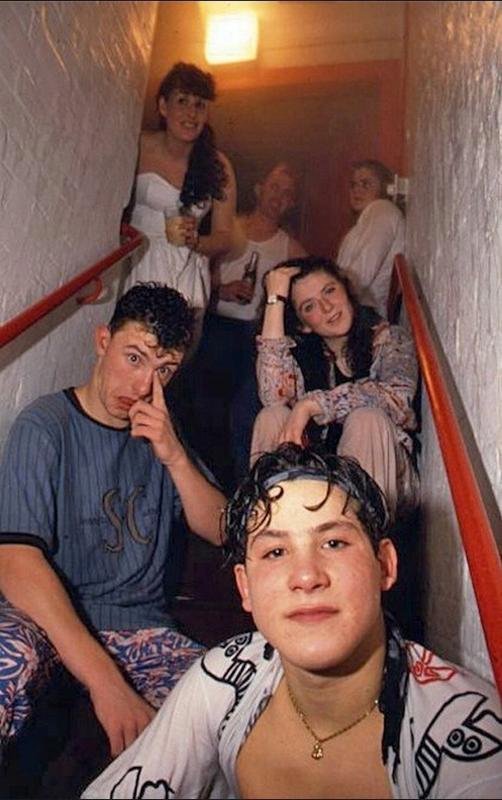
On the stairs at Shoom (Picture by Dave Swindells)
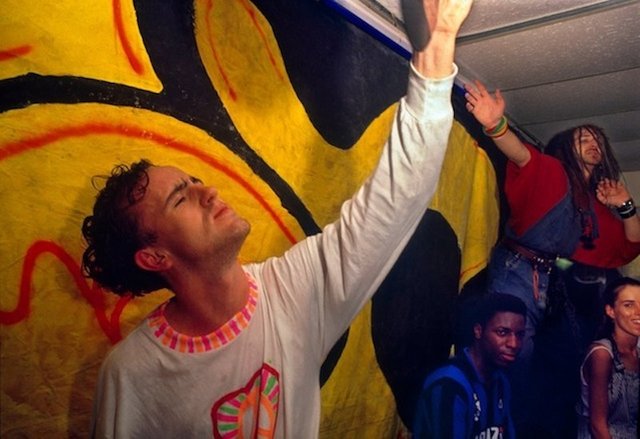
In ecstasy at Shoom (Picture by Dave Swindells)
Pete Heller: "Shoom. Smoke filled, strobe pulsing, sweat pouring, everyone rocking, stomping, whistling jack, jack jack!"
https://thump.vice.com/en_uk/article/ae83eb/heller-and-farleys-comprehensive-history-of-clubbing
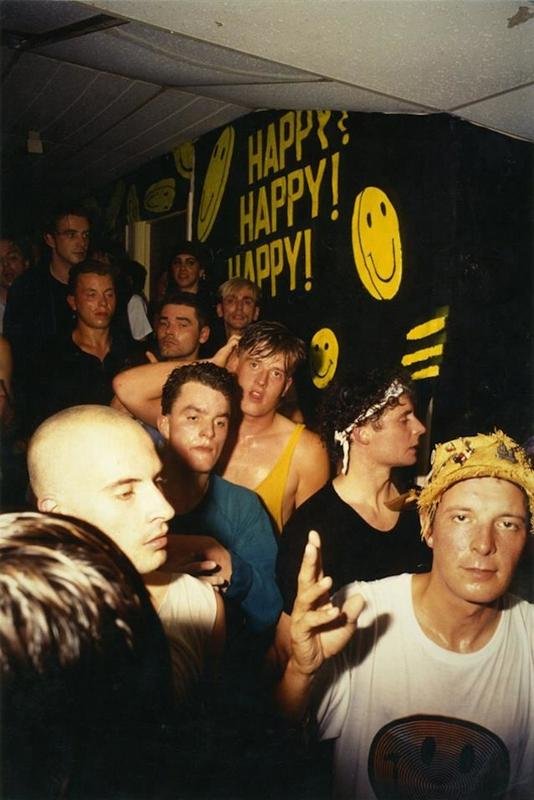
On the stairs at Shoom (Picture by Dave Swindells)
Carl Cox: "Acid Trax" by Phuture was just sick. It didn't do anything apart from eleven minutes of that acid sound. In amongst all that smoke and haze and fog it would just do your head in; that track was amazing. Bear in mind that Shoom was a fitness centre, that was just a room with mirrors in it. Banners, big sound system, loads of smoke, a couple of oil wheels, two strobes and "let's go". I'd probably go there today and think "was this it?"
- Paul Oakenfold: The Authorised Biography by Richard Norris
Phuture - Acid Tracks
Mark Moore: "The first time I went to Shoom it was all smoke and strobes, people wandering around like Night Of The Living Dead, waiting for their Es to come up. I was confused - Colin Faver had told me this place was rocking, but everyone was just shuffling round like zombies. I didn't get it. Then, slowly people started getting madder and madder. I look into their eyes and thought "Hang on a minute, I know what's going on here!" For some reason Shoom was more debauched than Future."
- Paul Oakenfold: The Authorised Biography by Richard Norris
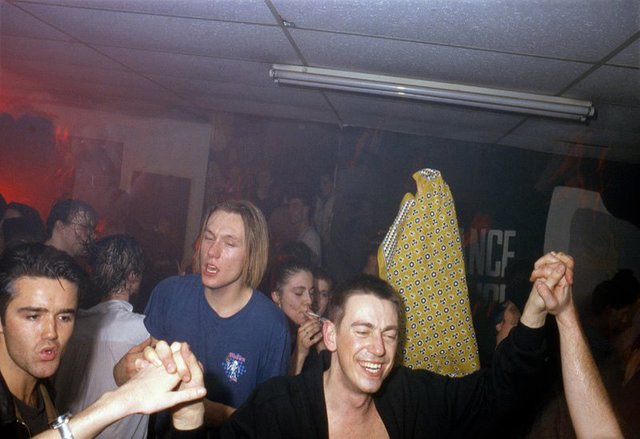
All joining hands at Shoom (Picture by Dave Swindells)
Terry Farley: "Another night, in the tiny gym basement that changed UK clubbing forever, had come to an end and the lights were on. But the room was still full of sweat and steam, and when Danny Rampling revived this soul classic (Joyce Sims - Come Into My Life) the whole crowd were holding each other, hands held aloft - E moments don't come much better than that!"
https://thump.vice.com/en_uk/article/ae83eb/heller-and-farleys-comprehensive-history-of-clubbing
Joyce Sims - Come Into My Life
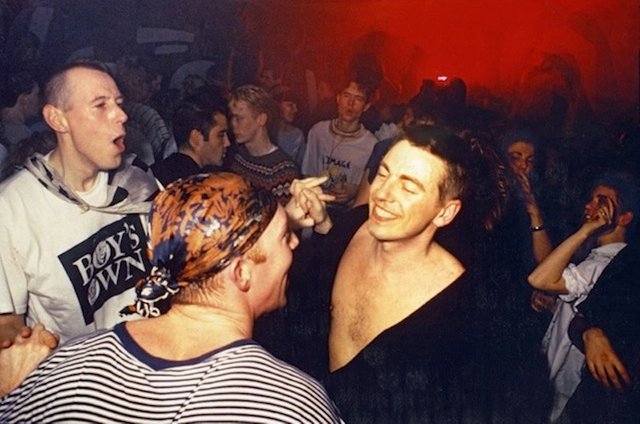
Joining hands at Shoom (Picture by Dave Swindells)
Mac Thornhill - Who's Gonna Ease The Pressure (Big Mac Mix)
Gene And Jim Are Into Shakes - Shake! (How About A Sampling Gene?)
Fini Tribe - De Testimony (Collapsing Edit)
Robert Owens - Bring Down The Walls
Illusion – Why Can't We Live Together
Phil Cheeseman: "I’d go to Delirium at Heaven and hear Frankie Knuckles, Daryl Pandy and Gordon Matthewman. I had some wild nights there, but I wasn’t blown away after what I’d seen in New York. I wasn’t amazed by anything until I went to Shoom. Delirium was like a holding spot. Four of us went to Shoom, dropped an E and got on the dancefloor. Most people seemed to hang in the bar area, but I’d be on the dancefloor mad dancing for hours. That’s when I thought it’s coming to London, that New York thing of intensity, drugs, the sounds. The combustion was there. There were little triggers all the way, it was cranking over. At Shoom the spark plugs hit the petrol.
Shoom was the first time I had come across a strobe and smoke machine on the dancefloor. It was very intense. I spent most of my time on the dancefloor and sweated a lot. People in the bar area were not that chatty with strangers, so it was sort of cliquey. I didn’t get into banter or make any new friends in the club, bar Danny and Jenni. The only reason we got in was that Julie, part of our team, knew Jenni because they used to sell shoes in the same shop in South Molton St. We wouldn’t have got in without that contact. There was no hugging or football thugs blissed out on E. It was almost a completely white crowd. I remember on the dancefloor being surprised when I saw a couple of black dudes watching me dance. I got vibed up on that.
The magical ingredients at Shoom were the small basement dancefloor that made the acoustics brilliant, the power-punched sound system and the strobe and smoke machines that intensified the experience. Ecstasy was the critical thing that made the whole Shoom experience unique. It was tight in there, intense, you could go wild on the dancefloor as hardly anybody could see you. It was like dancing in heaven as the smoke billowed out and the flashing strobe bleeped in your brain. You could really freak out. Hedonism wouldn’t have happened without Shoom."
http://www.hedonism1988.co.uk/history/
Shoom was certainly a cultural bakery that gave many people their first break in the scene, people like Terry Farley, Andy Weatherall and Steve Proctor, or trumpeter Gordon Mattewman, who went on to DJ at the legendary Hedonism warehouse parties and eventual become DJ Edge, founder of Edge Records. The open and friendly attitude in the club spurred on many many fan letters to Danny and Jenni thanking them for the life changing experiences that had taken place on that smoke filled, strobe soaked dancefloor. This was not just another nightclub, this was something completely special. Something that would become huge. Something that birthed a whole industry. Clubbing became a way of life for many, rather than just the social occasion it was before. People lived for the weekend. People had found freedom.
There is no video footage out there of Shoom at the fitness centre but (so you can get an idea of the size of the place) here is a short clip from Steve Proctor's Promised Land night, which took over the venue in '89 after Shoom moved on.
Promised Land - Lights On
Man, that's damn great job! Will do the both parts at the vacation
Thank you!!
Thank you. I will have another part coming soon. Part 3: Acid House, which will cover the period when it all broke into the mainstream throughout 1988.